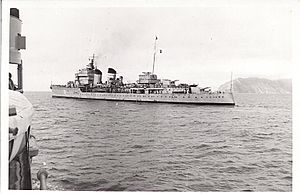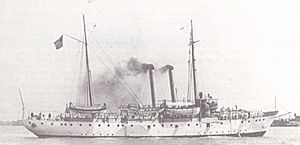Miguel Buiza Fernández-Palacios facts for kids
Quick facts for kids
Miguel Buiza
|
|
|---|---|
| Birth name | Miguel Buiza Fernández-Palacios |
| Born | 25 January 1898 Sevilla, Andalusia, Spain |
| Died | June 23, 1963 (aged 65) Marseille, France |
| Buried |
Hyères graveyard, Var
|
| Allegiance | |
| Service/ |
Spanish Republican Navy |
| Rank | |
| Battles/wars | Spanish Civil War Tunisia Campaign |
| Awards | |
Miguel Buiza Fernández-Palacios (born January 25, 1898 – died June 23, 1963) was an important officer in the Spanish Navy. He is most famous for leading the Spanish Republican Navy during the Spanish Civil War. After the war, he lived in exile in Marseille, France, where he passed away in 1963. Even though he was a very high-ranking officer, some sources say he never officially became an admiral, but remained a captain.
Contents
Miguel Buiza was born in Seville, Spain, into a wealthy family who owned factories. In 1915, when he was 17, he joined the Naval Academy in San Fernando, Cádiz. He worked hard and by 1932, he had become a lieutenant commander in the Spanish Republican Navy.
In 1936, when the Spanish Civil War began, Miguel Buiza was in charge of a military tugboat called Cíclope. He chose to stay loyal to the government of the Second Spanish Republic and did not join the rebel forces. Sadly, his brother Francisco, who was an army commander, joined the rebels and was killed early in the war.
Role in the Spanish Civil War
Fighting for the Republic
At the start of the war in August 1936, Miguel Buiza helped block the Strait of Gibraltar. He was commanding the light cruiser Libertad. Later that month, he took part in the Battle of Majorca. This was an attempt by the Republic to land troops at Porto Cristo, but it was not successful.
On September 2, Miguel Buiza was given a very important job. He was named Captain General of the Republican fleet by Indalecio Prieto, who was the Navy and Air Minister. At only 38 years old, Buiza was still in command of the Libertad. After the war started, many top commanders had joined the rebels. So, Prieto worked to reorganize the Spanish Republican Armed Forces and bring back order to the Navy.
Leading the Fleet
In September 1938, the Spanish Republican fleet suffered a tough loss at the Battle of Cape Cherchell. Mistakes by the Republican commanders led to two cargo ships being lost. Because of this, Miguel Buiza was removed from his role as Navy commander. Captain Luis González de Ubieta took his place and was promoted to admiral. Even though the Republican Navy had more ships, President Manuel Azaña was disappointed that its commander seemed unsure.
After being removed, Buiza was moved to different jobs, like inspecting naval bases or being the Navy's Chief of staff. But in February 1939, he was given back his important role as Captain General of the Republican Armada.
End of the War and Escape
Soon after, on March 5, 1939, Colonel Segismundo Casado of the Spanish Republican Army started a rebellion. He wanted to make peace with the rebel side and end the war, which Miguel Buiza also supported. On the same day, the rebel air force bombed Cartagena, the main base for the Republican Navy. A destroyer was sunk, and there was a lot of chaos in the city.
Because of the bombing and fighting in Cartagena, Miguel Buiza decided to evacuate the Navy's ships that could still sail. As night fell, at least three cruisers, eight destroyers, and two submarines left Cartagena harbor and headed out to sea.
The fleet sailed east, led by Miguel Buiza on the cruiser Miguel de Cervantes. They reached the waters near Algeria. Buiza asked to anchor there, but the French authorities in French Algeria sent them to Bizerte in French protectorate of Tunisia. The fleet arrived on March 7. Soon after they anchored, the French authorities took control of the ships. Most of the Spanish sailors and officers were sent to a camp at Meheri Zabbens, which was an old mine. Miguel Buiza refused any special treatment and chose to stay with his sailors.
Life in Exile
In May 1939, after the Spanish Republic lost the civil war, Miguel Buiza asked the French government if he could join the French Foreign Legion. He was accepted as an officer with the rank of captain. By the start of World War II, he had been promoted to commander. However, in mid-1940, he left the Legion. Some say he was forced out by the new French government because he had fought against fascism.
Miguel Buiza then moved to Oran, Algeria, where he worked as an accountant in a hotel. In 1947, he was asked to help with a special mission. He was recruited by Zeev Hadari to help Jewish people move to Palestine. This was against British rules at the time.
Using the name "Moshé Blum," Buiza became the commander of a merchant ship called Geula. This ship used to be the USS Paducah. On October 2, 1947, the ship was stopped while trying to bring Jewish refugees to Palestine. Buiza was arrested by the British and held in a camp near Haifa.
After he was set free, Miguel Buiza went back to Oran. In 1962, Algeria became independent, and many people of European descent, called Pieds-Noirs, moved to France. Buiza joined them and became a refugee in France.
Miguel Buiza died in exile in Marseille, France, on June 23, 1963. He had only been in France for about a year and never got to return to his hometown of Seville. He is buried in a graveyard in Hyères. His wife published a short notice about his death in a Spanish newspaper less than two months later.
See also
 In Spanish: Miguel Buiza Fernández-Palacios para niños
In Spanish: Miguel Buiza Fernández-Palacios para niños




